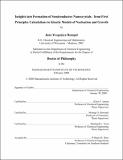| dc.contributor.advisor | Klavs F. Jensen, Moungi G. Bawendi and Bernhardt L. Trout. | en_US |
| dc.contributor.author | Rempel, Jane Yevgeniya | en_US |
| dc.contributor.other | Massachusetts Institute of Technology. Dept. of Chemical Engineering. | en_US |
| dc.date.accessioned | 2008-09-02T17:59:20Z | |
| dc.date.available | 2008-09-02T17:59:20Z | |
| dc.date.copyright | 2008 | en_US |
| dc.date.issued | 2008 | en_US |
| dc.identifier.uri | http://hdl.handle.net/1721.1/42075 | |
| dc.description | Thesis (Ph. D.)--Massachusetts Institute of Technology, Dept. of Chemical Engineering, 2008. | en_US |
| dc.description | This electronic version was submitted by the student author. The certified thesis is available in the Institute Archives and Special Collections. | en_US |
| dc.description | Includes bibliographical references (p. 195-202). | en_US |
| dc.description.abstract | Over the past decade the synthesis of colloidal semiconductor nanocrystals of diverse shapes and sizes has sparked tremendous interest in both the industrial and scientific communities. Much of the work thus far has been done by extensive trial-and-error optimization of the chemistry to produce the desired nanocrystalline product. However, despite a tremendous effort in developing adaptable chemistries, the underlying mechanisms leading to nucleation and crystal growth in these systems are still not well understood. This thesis aims to address this challenge by utilizing first principles calculations and mathematical modeling to study the formation of cadmium selenide nanocrystals, the most frequently studied and best characterized nanocrystal system. In the first part of this thesis we investigate the elementary reaction steps that occur in the organic medium during early stages of particle nucleation. In particular, using density functional theory calculations, we probe the mechanism of formation of active growth species and small molecular clusters. We further explore the effect of ligand stabilization on cluster formation. In the second part, we explore reactions occurring on various surfaces of CdSe at later stages of crystal growth using periodic density functional theory calculations. Homoepitaxy and heteroepitaxy reactions on several relaxed and reconstructed wurtzite CdSe surfaces are investigated. Furthermore, the effect of ligand binding on crystal growth is examined using several model ligands. We show that ligands exhibit a range of affinities and selectivities for different facets of CdSe. We relate our findings to experimental observations, in particular, nanocrystal morphology and shape anisotropy. Finally, utilizing experimental and computational insights, we develop a mathematical model that explains both nucleation and growth in the formation of nanocrystals. | en_US |
| dc.description.abstract | (cont.) Cluster formation is modeled using a population balance approach combining discrete and continuous Fokker-Planck rate equations for small and large-sized clusters, respectively. The model explores the relative importance of factors such as temperature, additives, and reaction versus diffusion control on the formation of nanocrystals. | en_US |
| dc.description.statementofresponsibility | by Jane Yevgeniya Rempel. | en_US |
| dc.format.extent | 202 p. | en_US |
| dc.language.iso | eng | en_US |
| dc.publisher | Massachusetts Institute of Technology | en_US |
| dc.rights | M.I.T. theses are protected by
copyright. They may be viewed from this source for any purpose, but
reproduction or distribution in any format is prohibited without written
permission. See provided URL for inquiries about permission. | en_US |
| dc.rights.uri | http://dspace.mit.edu/handle/1721.1/7582 | en_US |
| dc.subject | Chemical Engineering. | en_US |
| dc.title | Insights into formation of semiconductor nanocrystals : from first principles calculations to kinetic models of nucleation and growth | en_US |
| dc.type | Thesis | en_US |
| dc.description.degree | Ph.D. | en_US |
| dc.contributor.department | Massachusetts Institute of Technology. Department of Chemical Engineering | |
| dc.identifier.oclc | 239085686 | en_US |
